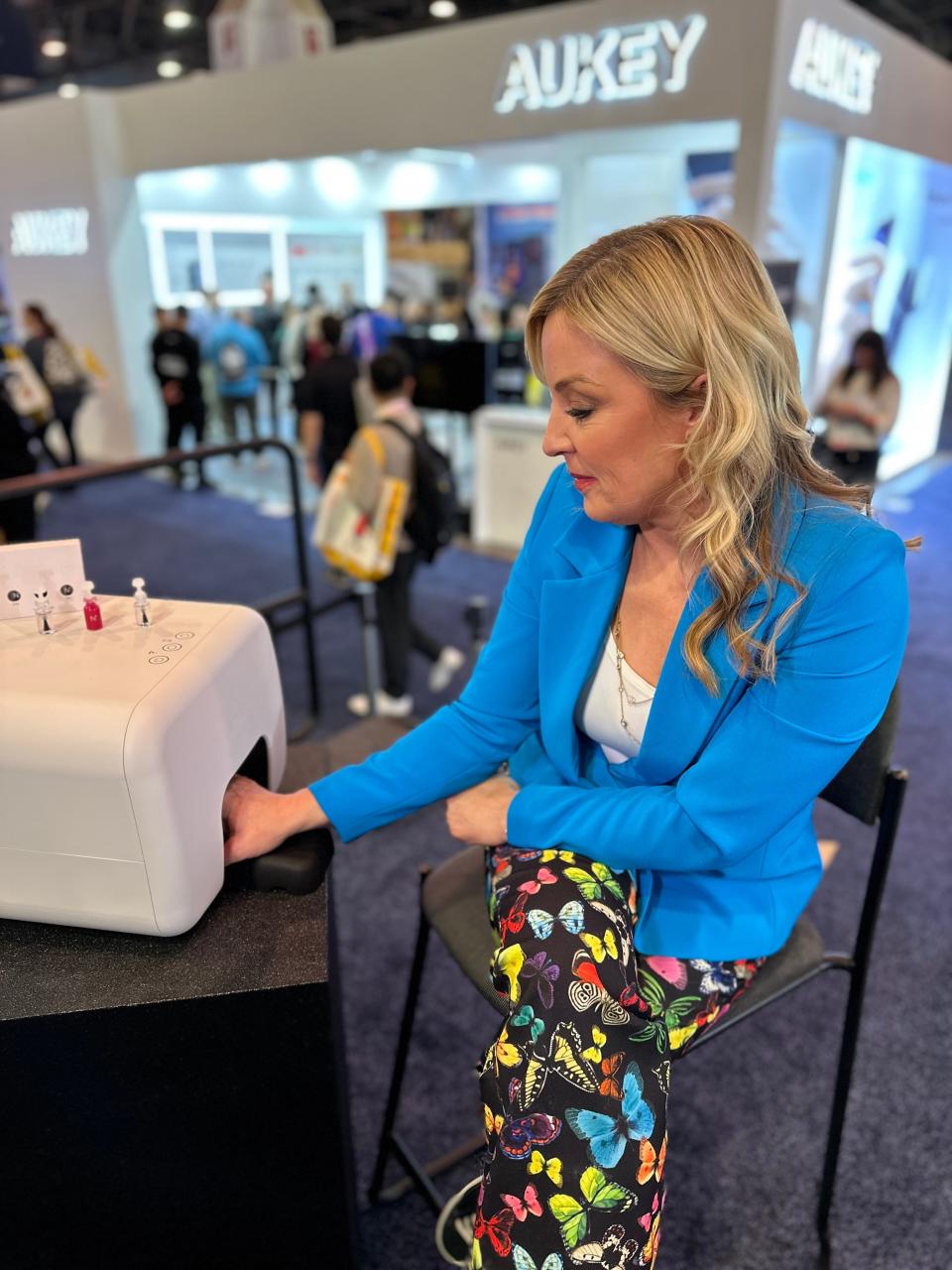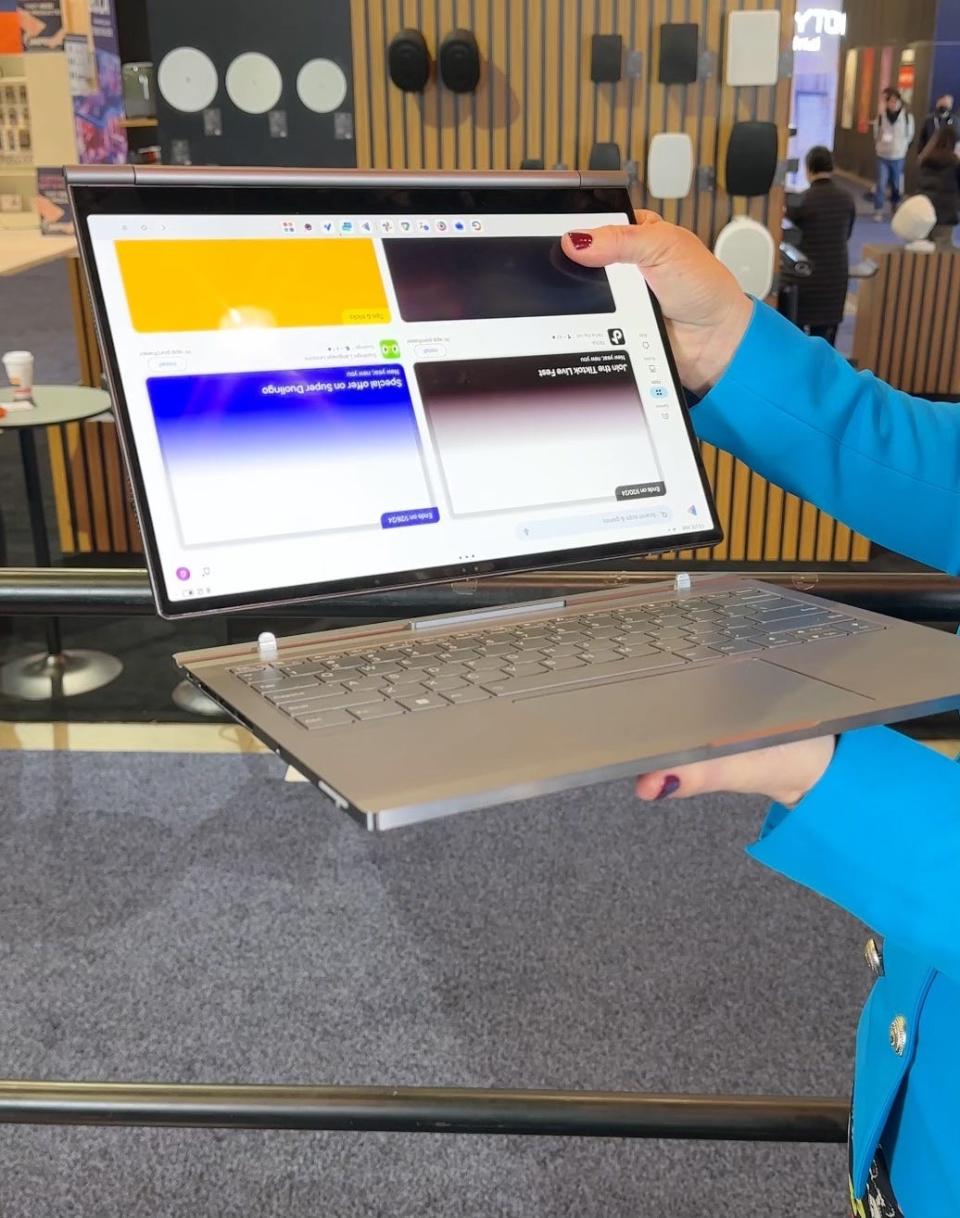CES highlighted the hottest gadgets and tools, often fueled by AI
For the 15 years that I’ve covered CES — one of the largest consumer electronics tradeshows in the world — the sheer numbers of people, gadgets, and overall hype is absolutely overwhelming.
Imagine the Las Vegas strip, with all its dopamine-pumping music, flashing lights, and psychological razzle-dazzle — then insert every kind of gadget and tech tool imaginable on top of it all.
Product pitches and company announcements promise to “enhance,” “enrich,” and “immerse” — the hyperbole flowing faster than the free drinks at a casino craps table.
That part of CES has not hasn’t changed at all. But make no mistake, this year’s show signals a seismic shift in our relationship with technology, mainly thanks to a giant infusion of AI.
It feels a bit like when the internet went from dial-up to broadband, to ‘how did we ever make it through the day without instant access to everything, everywhere, all at once?’ It was the same with the evolution from cell phones to smartphones.
You might not be old enough to remember the “before” times, but I am. It didn’t happen overnight, but those events profoundly changed our lives. We’re going through something similar again now.
Here are a dozen of the best and most interesting new products I could get my hands on at CES and their role in foreshadowing what’s ahead.
Robots that clean, pamper and play
Robots are always a big draw at CES, but they’re usually more far-out fantasy than mainstream must-haves. The missing ingredient’s always been the more mature and robust machine learning that gives a hunk of parts and processors the ability to learn, adapt, perceive, and perform autonomously, in real-time and in ways that are more helpful than creepy.
Matic Robotics' completely re-engineered robot vacuum and mop combo is a great example here. It uses five onboard cameras and AI to mimic how humans see and figure out space in a home and builds a photo-realistic 3D map of your home in near real-time. Then, it navigates, patrols, and cleans without getting stuck, running into obstacles, or falling down stairs. As a result, it cleans better, more quickly, and even more quietly — 55 decibels, the volume of a quiet conversation — than any other robot vac I’ve ever reviewed. It understands gestures and voice commands, so you can point to something and say, “Hey, Matic, clean this,” and it’s on the job. The founder told me that Matic is private by design and doesn’t upload any information to the cloud — it’s all completely contained on the device itself. The cost is $1,495 through the end of February, then rises to $1795. It ships in March.
LG’s “Smart Home AI Agent” zooms around your house independently like a mini Rosie from Jetsons. It can talk with you, interact, and express emotions through movements, thanks to articulated leg joints. It can also integrate with all of your appliances like your oven, laundry, TV, and smart fridge — almost like a virtual personal assistant — but not just virtual anymore. It can wake you up in the morning, remind you to take your medicine, ask if you need your heat turned up when it’s cold outside, greet you at the door when you come home, and so on. AI enables it to understand context and intentions, getting more personalized over time. It functions as an adorable run-around smart home hub. There’s no word on price or cost yet, but LG told us to expect them to launch “in the near future.”
Nimble’s beauty-bot paints your nails like a pro — at home. It uses 2D and 3D scanning technology and advanced AI to learn your nails' exact size, shape, and curves. Then it scans, paints, and dries in as little as 25 minutes for an “express” manicure (there’s a 55-minute version that does more coats, too). Best of all, it's available 24/7 (no appointments needed), flexible, easy to use, and convenient. It’s available for pre-sale now for $599 but is expected to be $699 when it comes out in March this year. That’s a massive chunk of change, but it pays for itself in a few months if you get regular manicures at a salon.

The most jaw-dropping, next-level upgrades
A lot of times at this show — and in general with consumer tech — year-to-year upgrades are super ho-hum. What might be a big deal to a company trying to get us to buy their newest gadget rarely justifies the expense. This year, that’s changed quite a bit with some standout tech that finally delivers some revolutionary – not just evolutionary – new features, tools, and satisfaction overall.
Urtopia’s new Carbon 1Pro e-Bike is a completely next-level upgrade, with onboard AI, LTE connectivity, and even a ChatGPT assistant (coming soon). There’s voice control for the lights and speed. The bike can even sense your environment. It knows when you’re on hills versus trails versus city streets and reacts with the “just right” level of assistance. You can lock it with a fingerprint, get notifications if it moves, and sound an alarm if someone steals it. It also leads authorities right to it, thanks to that constant 4G connection, which has already led authorities to stolen Urtopia bikes. It can go 80 miles on a single charge, and at just 37 pounds, it’s one of the lightest e-bikes I’ve ever reviewed. It will come out “after March this year” and is available for pre-order now for just under $2,500.
Leave it to Kohler to redesign the humble showerhead. Its SpaViva Handshower delivers a new kind of tricked-out tech to transform your boring bathroom into a luxury spa. The outer ring of the device shoots “microbubbles” to give you a hydrofacial-style cleanse. You can swap out the middle part of the shower head for a rotating face brush, body brush, body scrubber, or, my personal favorite, a body massager. All of the attachments recharge through a magnetic dock. Kohler expects it out in Q1 this year for around $300.
Lenovo’s ThinkBook Plus Gen 5 Hybrid is a real show-stopper in the laptop category. It’s a full Windows PC and Android tablet. Together, it’s a new high-end laptop. But then you can lift the 14-inch screen up and off — and voila — it gives you two completely separate devices. The top becomes an excellent upgraded tablet, while the bottom half delivers a full Windows PC that you can use with another monitor. The company says it will launch Q2 this year for $1,999.
Also out of Lenovo, its Magic Bay Studio is the exact little snap-on cutting-edge 4K camera with integrated speakers we’ve all wanted for video and conference calls since Covid’s work-from-home years showed us how bad our device’s on-board cameras are. This attachment snaps on with robust little connector pins and automatically “talks” to the device so it’s ready to roll in a second or two, with no additional apps or lag time. They also showed off a concept fan, LED “beauty light,” and a super cute little robot companion that will hopefully come soon, but the webcam comes out in April ($199) this year.
Hyundai Motor Group’s air mobility offshoot Supernal unveiled its S-A2 Air Taxi, showing us what a high-end helicopter will look like in about four years. There’s room for one pilot and four passengers. The fully electric aircraft takes off and lands vertically and flies 120 miles per hour at altitudes of about 1500 feet. That means it fits that perfect sweet spot for going the 25-40 miles between a place like downtown Manhattan to JFK, the kind of route helicopters cover for people who can afford to travel that way. One of the most incredible aspects of it is how little noise it makes. It’s as quiet as a dishwasher. It’s expected out in 2028.
The best (and most fun) new tech you can buy right now
Often at these shows, we see a lot of concepts and prototypes that fizzle out before ever going on sale. We saw more devices this year that launched and went on sale this past week or have confirmed shipping dates that aren’t too far away. That means more gadget-makers are moving past good ideas to deliver on their promises.
AI: Robots powered by AI were highlighted at CES 2024
Reviewed editors choice: What were the top items at CES?
I never realized how overdue backyard grills were until I reviewed Current Backyard’s new dual-zone grill. It’s the first full-size electric barbecue that makes me think I might finally be capable of cooking outside on a barbecue and actually being good at it. The e-grill makes it easier and safer overall. There are no open flames — you can just set it and forget it. There’s no smoke, but it still delivers that traditional smoky flavor. It’s Wi-Fi enabled so that you can tap the app on your drive home, have it heated, and throw the meat and veggies on the minute you arrive. There are zero emissions, so it’s better for the planet. This model starts at $899 and ships next month.
If you love to ski and want to do it all year round, anywhere you happen to be, the new SKWHeel (ski+wheel) electric skis are a perfect fit. You step into them with your regular shoes, and the bindings come up on the back of your leg just below your knee, so they feel like skis. With the front wheel system gliding you along — gravel, grass, asphalt, sand — you feel even more like you’re out on the slopes, minus the cold. They make gliding turns, and you can even pizza/french fry if you need to! You control them with a handheld remote, and they go up to 50 miles per hour and nearly 20 miles on a single charge. They’re selling via Indiegogo for about $1,600 and will ship out in June.
Now for a tiny gadget with a considerable impact: Shelly’s quarter-size Mini Gen 3 relays make any standard wall switch or socket — smart. They are among the smallest relays in the world, adding instant automation to lights, garage doors, electrical appliances, etc. That means you can control them from anywhere in the world from an app on your mobile device. I was surprised by how easy these are to set up myself, and they work with most existing smart ecosystems. They start at just under $12 and started shipping out during CES.

The Barsys 360 cocktail maker is an automated mixologist that looks beautiful on a countertop and crafts fresh cocktails at the tap of a Bluetooth-connected app. Pour your favorite spirits, juices, or drink add-ons like simple syrup into one of the six 30-ounce compartments on the device. Then, the app gives you ideas of what to make from some 2,000 recipes, or you can tell it how to make your favorite drink. Once you choose, just put the right glass in — and CHEERS! — don’t forget to tip your bartender on the way out. It starts shipping on January 24th and costs $425.
Jennifer Jolly is an Emmy Award-winning consumer tech columnist and on-air correspondent. The views and opinions expressed in this column are the author's and do not necessarily reflect those of USA TODAY. Contact her at JJ@Techish.com.
This article originally appeared on USA TODAY: CES 2024: Seismic shift in tech was on display thanks to rise of AI

